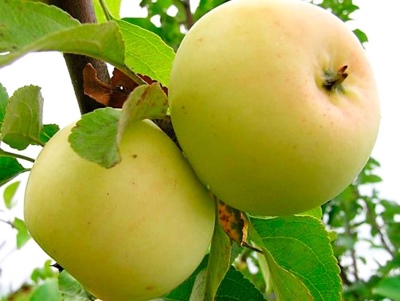
- Taste: sweet and sour
- Scent: moderate
- Fruit weight, g: 140-180
- Yield: up to 80 kg per tree
- The beginning of fruiting varieties: for 5 years
- Ripening terms: late summer
- Removable maturity: In the end of August
- Keeping quality: up to 3 months
- Appointment: universal
- Growing regions: Ural, Povolzhsky, Central, Volgo-Vyatsky, West Siberian
Among all fruit trees, gardeners most often choose the apple tree. The fruits of this culture are distinguished by their delicate taste, they are incredibly healthy and can become an ingredient in many delicious dishes. Apple-tree Iset white is a very frequent decision of Russian farmers. Bred on the basis of the Sverdlovsk Experimental Station, this type of fruit tree demonstrates excellent characteristics of yield and taste.
Description of the variety
The white Iset is a medium-sized tree with a rounded crown of medium density. Has a dark gray or brown bark. Shoots are located compactly, crowded, they are distinguished by good thickness, not curved. They have a brown tint and slight pubescence. The foliage has a wide oval shape and a dark green color. The leaves are large in size and smooth. The flowers are small, gather in inflorescences, shaped like umbrellas. The flowers are white or pink in color and have a strong scent that attracts bees.
Features, pros and cons
The Iset white apple tree has the following positive qualities:
high winter hardiness;
a large number of fruits;
undemanding care;
excellent keeping quality and transportability;
pleasant fruit taste.
There are quite a few cons:
the variety is not completely scab resistant;
when stored on fruits, an oil bloom is noted.
Ripening and fruiting
Belaya Iset belongs to late summer varieties of apple trees. Removable maturity begins at the end of August. The first fruiting occurs in the 5th year of the tree's life.
Growing regions
White Iset is grown in many places in Russia, but the following growing regions are most common:
Ural;
Povolzhsky;
Central;
Volgo-Vyatsky;
West Siberian.
In general, the apple tree of the described variety is recommended for growing in places where there are snowy frosty winters and short summers.
Yield
The yield is good. If the gardener takes proper care of the tree, he can harvest up to 80 kilograms of apples from it.
Fruits and their taste
The white isset gives fruits of universal use. They can be eaten right away, put in compote, twisted into juice or jam, and other uses can be found. The apples are light yellow. The shape is rounded, slightly flattened. The apple is quite large - the average fruit weighs about 140-180 grams. The skin is thin, but dense, although there is no stiffness in it. It is smooth to the touch.
There are very few subcutaneous points, and they are light. The taste is harmonious, sweet and sour, classic apple. The white pulp is juicy and fine-grained. Its density is medium, and the aroma is moderate. In cool conditions and with ventilation, the fruits can lie for up to 3 months.

Growing features
The Iset white apple tree grows best in flat and sunlit areas, protected from wind and close groundwater. It is also important to take care of the distance between the seedlings. It should be at least 3 meters. A mandatory moment will be a pole, which at first will serve as a support for a weak seedling.
In order for the White Iset to develop correctly, she will need pruning. In the first year of life, the central conductor has to be removed to give strength to the side bushes. Subsequently, all increments are shortened by exactly one third. Do not forget about standardizing and sanitary pruning: remove diseased branches, specimens affected by pests, as well as those that interfere with the correct growth of the crown.



Pollination
The cultivar is partially self-fertile, so it is important to take care of the pollinators. Pollinating trees are planted at a distance of 50 meters from Belaya Iset. The variety does not matter, but the moment of flowering should be exactly the same.
Top dressing
Fertilizers begin to be given for 2-3 years. The more years the tree is, the more concentrated the composition should be. All dressings are made into the grooves dug along the perimeter of the trunk circle.
The schedule is as follows:
after spring pruning, nitrogen is introduced;
in the process of flowering, the tree is supplied with superphosphate and potassium sulfate;
after flowering, they give nitroammofoska and sodium humate;
at the end of the harvest, potassium and superphosphate are added.

Frost resistance
White Iset is very resistant to frost. Trees almost never need shelter. Close only very young trees that can quickly freeze. They are covered with agrofibre or spunbond, or burlap. The trunk circle is mulched.

Diseases and pests
The apple tree is rarely affected by diseases, but its resistance to scab cannot be called one hundred percent. In addition, the White Iset can be attacked by:
rose leaf rollers;
green apple aphid;
apple moth.
It is recommended to get rid of insects with insecticides. If birds that spoil the fruits often arrive, you should think about ultrasonic scarers.

The apple tree is a popular fruit crop among gardeners. It can be found in many summer cottages. But at the same time, such trees are often affected by various diseases. It is very important to recognize the disease in time and carry out the necessary procedures for a speedy recovery. Otherwise, the fruits will be spoiled, and the tree itself may die altogether.












































































